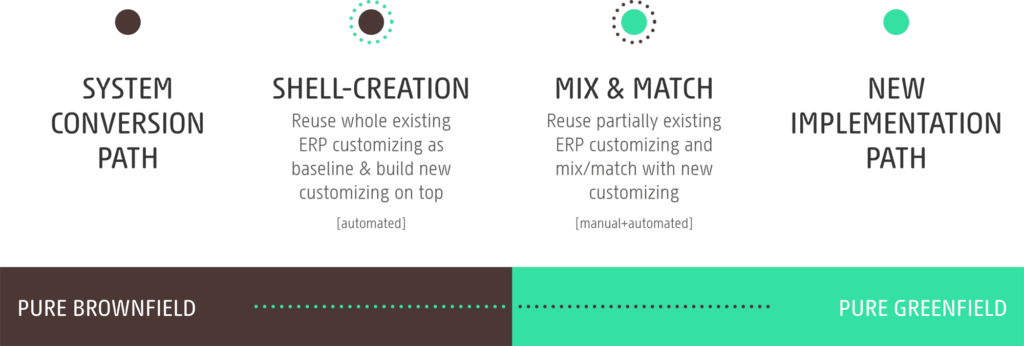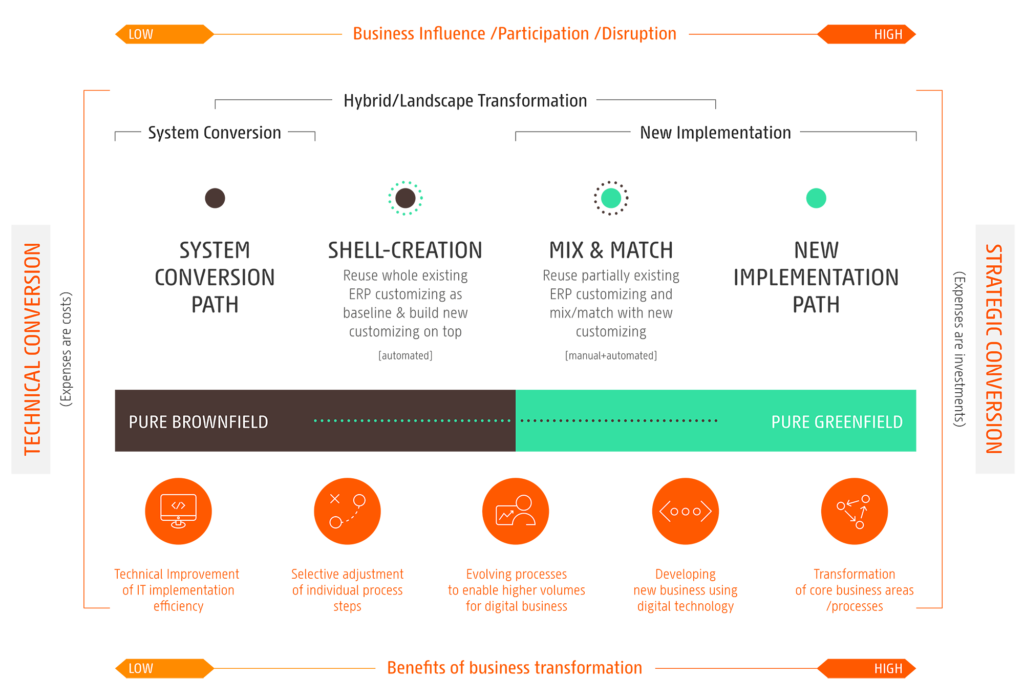Digital transformation awaits all large companies. When deciding to implement key changes regarding the systems used in our company, we must take into account the constant factors – the need to maintain work continuity and optimal process flow. It is, therefore, definitely worth approaching the conversion by the book – following the SAP S/4 HANA implementation steps consistent with the SAP methodology. It is also important to ask the following question: can such a change facilitate development?
Time is key
We can wait until the last moment with the decision to convert our SAP system to S/4HANA. But this is not the best solution. Why? The time buffer until 2027 may seem sufficient. But if we look at it from the perspective of the time required to analyze the company’s situation and its willingness to adapt to S/4HANA (so as to gain the most benefits) and then we add the time needed for the actual conversion of the system – we may end up dangerously close to the deadline. Postponing the beginning of the implementation process for several years will make it very difficult to queue the works with Partners who can be entrusted with the digital transformation of your business (since most companies will probably wait until the last minute as well). The key question in this case is: can your company afford not to optimally support the latest technologies, which are also commonly used by your competitors?
The safe first step of SAP S/4HANA implementation
When following the guide to SAP S/4 HANA implementation, every company using SAP software and planning the conversion needs to go through the first phase of implementation, i.e. confrontation of the capabilities offered by S/4HANA with its business processes. But not only that. This is the time to analyze the company’s business goals and adapt the solutions proposed by SAP with these goals in mind.
There are numerous solutions used on the market for such large projects as conversion to a new version of the SAP system. Hicron proposes a SAP S/4 HANA implementation roadmap that enables the deep analysis and proper distribution of this process over time. First of all – our main goal is not to simply adapt the system to the business processes of the company, but to design its capabilities in a way that makes the achievement of business goals much more effective.
This is why we treat the first phase of conversion to S/4HANA as a separate offer, whose final product is a complete roadmap. We use it to explain how a company should prepare for the conversion and how to carry it out – all in accordance with the guide of SAP S/4 HANA implementation. It is also the time to gather key information, i.e. SAP S/4HANA capabilities, planned expenses, and time required.
The first phase of conversion to S/4HANA (and, at the same time, the first stage of the implementation process) consists of several key steps. They are designed to answer priority questions, and thus plan the most optimal course of action.
- READINESS CHECK:
Standard report used for technical and business analysis of the system in terms of its readiness for the planned conversion. The results of this report will be used by the project team to determine the most favorable conversion path to SAP S/4HANA. - SIMPLIFICATION ITEM CHECK:
List of technical and business elements of the current SAP ECC system that require key changes. Understanding these changes and the way processes are implemented in the new environment is one of the key elements when deciding on the path to S4HANA implementation. The Simplification Item Check answers the question posed by the project team: are the current processes supported in the new environment (and if not – how do the new ones look?) and what should be done with the current system to enable the conversion? - CUSTOM CODE CHECK:
Verification of the ABAP code for correctness and compatibility with S4HANA programming standards; this includes the valuation of adapting SQL queries in ABAP programs to the current standards and requirements, as defined by S4HANA. Determining which development solutions are used for production in business processes (accuracy depends heavily on the amount of time available for the collection of this information). - SYSTEM ARCHITECTURE:
Based on the information collected during the Readiness Check and functional workshops with the Client, BASIS consultants together with the local IT department will analyze the available infrastructure elements and, on this basis, propose the target environment architecture at the level of SAP S/4HANA applications. The specific architecture will be used by the Client during arrangements with the Equipment Service Provider to build a physical environment (hardware, OS, LAN). - SYSTEM SIZING:
Estimation of the required individual equipment resources for the application server and databases (processor, RAM, memory, network) based on:- agreed architecture,
- collected information on business processes and number of documents,
- size of the current system,
- data growth declared by the Client,
- verification based on Quick Sizer,
- reference values.
The scope of analysis carried out by Hicron was based on the best SAP standards, in accordance with the SAP Active methodology. Works can be carried out in all functional modules that the company uses or wants to use (FI, FI-AA, CO, SD, MM, PP, WM). All elements are aimed at detailed verification of the system functioning in the enterprise as well as defining and planning low-level tasks in the process of conversion or reimplementation to S/4HANA.
Which conversion path to choose?
So, we confronted the capabilities of S/4HANA with the needs of the company. Now it is time to choose a conversion scenario. SAP proposes two basic roadmaps of implementation: technical conversion (BROWNFIELD) and system reimplementation (GREENFIELD). Both depend, on the one hand, on financial capabilities, investment capacity, and verification of long-term business plans and, on the other, on the current SAP ECC system implemented in the enterprise.

- BROWNFIELD (SYSTEM CONVERSION PATH)
Technical conversion, which requires little redesign of business processes (Simplification Item Check). It involves 1:1 transfer of processes from the previous SAP version to the new S/4HANA platform.
- What are the benefits of this path?
- Reduced implementation time.
- Lower costs.
- No need to change the structure of business processes.
- Access to the main new functionalities of S/4HANA: SAP Fiori, Embeded Analytics, HANA database.
- What are the disadvantages of this path?
- Minimal use of certain new functionalities available in S/4HANA.
- GREENFIELD (NEW IMPLEMENTATION PATH)
System reimplementation, which focuses primarily on a long-term approach, as it takes into account both the use of the new capabilities offered by S/4HANA and achieving long-term competitive advantage.
- What are the benefits of this path?
- Redesigning and refreshing the company’s business processes.
- Significant increase in system capabilities.
- Improved competitive advantage.
- Digital business transformation.
- What are the disadvantages?
- Implementation can take much more time.
- Employees need to be prepared for changes in the company.
- Higher costs (investments).
It is, of course, possible to establish paths in between the two presented solutions, containing more elements of either technical implementation or system reimplementation (such as SHELL-CREATION or MIX&MATCH). It all depends on the requirements and capabilities of the company and its openness to development and change.

It cannot be denied that all scenarios – both technical conversion, reimplementation, as well as intermediate paths – require proper preparation for their efficient and agile execution. Only a well-developed SAP S/4 HANA implementation guide, taking into account all individual solutions used in the company, can guarantee the expected improvement in performance and faster development.

This is why pre-implementation analysis is the first step preceding such a significant change. Its purpose is both the examination of the current system architecture and deep analysis of the company’s business processes.
Why should you take the first step in SAP S/4HANA implementation now?
- Transition to S/4HANA is something all companies using previous versions of SAP software will have to do – which means that the analysis will be carried out in each of them.
- You can find out in advance which scenario will be best for your company and budget the proposed solution for the coming years. Hicron’s analysis does not oblige your company to sign a contract for the entire implementation. We provide you with a complete implementation plan for the new system.
- This solution will help you change your system in a more balanced way and open your company to the possibilities of faster development.
Upgrading the SAP system to its latest version is an opportunity worth pursuing. The earlier the analysis of the current system architecture and processes is carried out, the sooner the company will be able to utilize the conveniences and capabilities of S/4HANA.
Apart from following the SAP S/4 HANA implementation guide, it is also important to choose the right Partner to guide us through the analysis process and, based on its results, execute the conversion or reimplementation.
Do you want to start the process of conversion to S/4HANA in your company? Get a quote for the first phase of conversion to S/4HANA? Or maybe you still have questions about the best solution? Arrange an online consultation with our employee who will answer your questions.
We can also conduct workshops for your company, resulting in a confrontation of the capabilities of the new system with its current architecture, which will help you learn more about the new functionalities.







